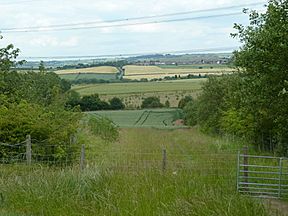Adelphi Canal facts for kids
The Adelphi Canal was a small, private canal built in Duckmanton, near Chesterfield, England, in 1799. It was used to move heavy pig iron from a factory called an ironworks to a loading area by a road. This canal was not connected to any other waterways. The iron was then taken by road to the Chesterfield Canal.
Contents
History of the Adelphi Canal
Why the Canal Was Built
The Smith family was important in the iron and coal industries in Sheffield during the late 1700s. One family member, Ebenezer Smith, owned an ironworks at Brampton. This factory made things like weapons and parts for Newcomen engines. These engines were used to pump water out of mines.
The Smith family also owned mines and ironworks in other areas. They built the Adelphi Ironworks in Long Duckmanton around 1799. This factory had two furnaces that could make 900 tons of pig iron each year. This iron was also used to make weapons.
Moving Iron in the Past
In the past, roads were often in very bad condition, especially in winter. This meant that ironworks had to store their products until summer. To avoid these delays, Ebenezer Smith decided to build the Adelphi Canal.
The canal was designed to move iron from the Adelphi Ironworks to a wharf near Tom Lane and Staveley Road. From there, the iron was transported by road for about 1.7 miles (2.7 km) to the Chesterfield Canal. Once on the Chesterfield Canal, the iron could be shipped to the River Trent and other places.
How the Canal Worked
The Adelphi Canal was about 1⁄2-mile (0.80 km) long. It was built as a wooden trough. Small boats, which could carry about 1.5 tons of iron, were used on the canal. The canal got its water from nearby mines. A special Newcomen engine, which had been improved by James Watt, pumped the water into the canal.
The iron had to be moved from the canal boats to road transport twice before it reached the Chesterfield Canal. It would have been easier to extend the canal further north. However, this would have meant crossing land owned by the Duke of Devonshire.
End of the Canal
The ironworks faced problems in the 1820s. In 1832, the Duke of Devonshire ended the Smith family's lease for some of their mines and iron sources. It is not known exactly when the Adelphi Canal stopped being used.
What Remains Today
The Adelphi Ironworks and the start of the canal were located just north of Arkwright Town. Some houses to the south of the ironworks were removed because of methane gas from the mines. Parts of the ironworks buildings were still visible at Works Farm until at least the 1980s.
Later, open-cast coal mining took place in the area. This type of mining removes the ground from the surface. As a result, most of the canal and ironworks have been destroyed. Today, only the weigh bridge and the pattern shop from the ironworks remain.
| Point | Coordinates (Links to map resources) |
OS Grid Ref | Notes |
|---|---|---|---|
| Adelphi Ironworks | 53°14′17″N 1°21′22″W / 53.238°N 1.356°W | SK430714 | Start of canal |
| Tom Lane Colliery | 53°14′20″N 1°20′49″W / 53.239°N 1.347°W | SK436715 | |
| Tom Lane/Staveley Road | 53°14′38″N 1°21′07″W / 53.244°N 1.352°W | SK432721 | The Poolsbrook crossed the roads here |


